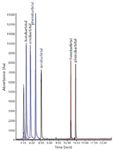Extraction of Barbiturates from Human Urine Using ISOLUTE+ Columns prior to GC–MS Analysis
Biotage Application Note
This application note describes the use of ISOLUTE SLE+ supported liquid extraction 1 mL sample volume columns to extract a range of barbiturates from human urine. The analysis of these analytes was carried out by GC–MS. This simplified and efficient extraction method has significant analyte recoveries ranging from 103–108% with limit of quantifications (LOQs) of 10 ng/mL and relative standard deviations (RSDs) <10%. Supported liquid extraction is an efficient and cost-effective alternative to traditional liquidliquid extraction (LLE) for bioanalytical sample preparation, providing high analyte recoveries, no emulsion formation and significantly reduced sample preparation time.
Extraction Conditions
This application note outlines the procedure using both the ISOLUTE SLE+ 1 mL sample volume column (part number 820-0140-C) optimized for a 1 mL pre-treated urine sample volume. Method parameters and dilution factors have been optimized to maximize recoveries and minimize ion suppression.
Sample pre-treatment: To 500 µL of urine add 100 mM ammonium acetate pH 5 (500 µL, 1:1, v/v).
Sample load: Load pre-treated sample (1 mL) to column followed by a pulse of vacuum to initiate flow and allow to absorb for five minutes.
Analyte elution: Elute with dichloromethane (2.5 mL). Leave to flow under gravity for 5 minutes, then follow with a further aliquot of dichloromethane (2.5 mL) and allow to flow under gravity for a further five minutes, to complete extraction apply a short pulse of vacuum.
Post extraction: Evaporate to dryness at room temperature (80 L/min) and reconstitute in ethyl acetate (200 µL).
GC Conditions
Carrier: Helium 2 mL min-1 (constant flow)
Inlet: Splitless, 150 °C
Injection: In-port flash alkylation:1 µL sample + 1 µL 0.2M TMAH (trimethylphenylammoniumhydroxide) in MeOH
Oven: 120 °C to 290°C at 15 °C min-1 , hold 2 min
Transfer line: 280 °C
Mass Spectrometry Conditions
Source temp: 230 °C
Quadropole temp: 150 °C
Solvent delay: 7 min
MSD mode: SIM
Results
Extracted samples demonstrated consistent recoveries between 103–108% with RSDs below 10%. LOQ was demonstrated at 10 ng/mL for all the analytes and this could be improved with more sensitive mass spectrometry. Figure 1 shows the overlaid chromatograms for all analytes.

Figure 1: Typical chromatograms for all barbiturate analytes at 10 ng/mL.
Conclusions
This method demonstrates a robust and effective extraction of a full range of barbiturates from the challenging biological matrix of human urine with clear and well-defined chromatograms.
Biotage AB
Kungsgatan 76, SE-753, 18, Uppsala, Sweden
tel: +46 18 56 59 00 fax: +46 18 59 19 22
E-mail: info@biotage.com Website: www.biotage.com

New Method Explored for the Detection of CECs in Crops Irrigated with Contaminated Water
April 30th 2025This new study presents a validated QuEChERS–LC-MS/MS method for detecting eight persistent, mobile, and toxic substances in escarole, tomatoes, and tomato leaves irrigated with contaminated water.
University of Tasmania Researchers Explore Haloacetic Acid Determiniation in Water with capLC–MS
April 29th 2025Haloacetic acid detection has become important when analyzing drinking and swimming pool water. University of Tasmania researchers have begun applying capillary liquid chromatography as a means of detecting these substances.

.png&w=3840&q=75)

.png&w=3840&q=75)



.png&w=3840&q=75)



.png&w=3840&q=75)


















